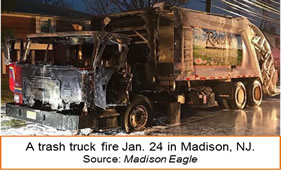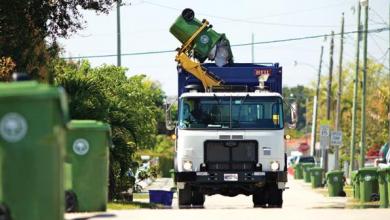By Annalloyd Thomason, Vice President/General Manager, NGVi
Refuse fleets are perhaps the largest market for CNG trucks. Their operating patterns of regular routes, return-to-base fueling and high fuel use make them ideal candidates to take advantage of the operating cost advantages of CNG.
There’s another operating characteristic, however, that requires special attention for CNG refuse fleets, and that is the frequency and type of vehicle fires. In addition to the more common electrical or engine fires that occur in other fleets, refuse fleets also deal with load fires—fires that begin in the box where trash is collected to move it to a transfer station or landfill.
Load fires are relatively common in the refuse industry, and there are standard protocols drivers are instructed to deploy when a load fire occurs. These may include either packing the load to deprive the fire of oxygen or, when possible, ejecting the load onto a flat, paved surface.
 Any refuse truck fire that occurs near the high-pressure CNG fuel system components, however—especially the CNG fuel storage cylinders—requires special attention due to the high pressures involved. In fact, several CNG refuse truck fires over the last eighteen months, including those in Indianapolis and New Jersey, have resulted in poor outcomes, including ruptured cylinders, injured firefighters and damaged property.While CNG is an inherently safe vehicle fuel, these recent incidents are causing refuse companies to look closely at their CNG safety protocols and training requirements, and make changes that will improve the outcomes of fires. Recently, NGVi was contracted by a major refuse company to conduct a safety evaluation of its entire CNG operation, and to identify practical, specific steps the organization could take to improve overall safety.
Any refuse truck fire that occurs near the high-pressure CNG fuel system components, however—especially the CNG fuel storage cylinders—requires special attention due to the high pressures involved. In fact, several CNG refuse truck fires over the last eighteen months, including those in Indianapolis and New Jersey, have resulted in poor outcomes, including ruptured cylinders, injured firefighters and damaged property.While CNG is an inherently safe vehicle fuel, these recent incidents are causing refuse companies to look closely at their CNG safety protocols and training requirements, and make changes that will improve the outcomes of fires. Recently, NGVi was contracted by a major refuse company to conduct a safety evaluation of its entire CNG operation, and to identify practical, specific steps the organization could take to improve overall safety.
As a result of this client project, we identified a four-point plan that every refuse company can deploy to minimize the risk from any CNG refuse truck fire. The four points include Driver Training, Driver Pre- and Post-Trip Inspection, Technician Training and Firefighter/First Responder Training. Let’s explore each of these further.
Implement Specialized CNG Refuse Truck Driver Training
Most refuse companies already provide training for drivers that includes what to do in case of a load fire in a standard diesel truck. However, because of the unique components of a CNG refuse truck’s fuel system, and because of the high pressures at which CNG is stored onboard these vehicles, CNG refuse truck drivers require a special training course. Without specialized training, drivers involved in vehicle accidents or fires are often automatically afraid of the high-pressure storage and tend to abandon their trucks without taking proper precautions when it is still possible to ensure their safety or the safety of the surrounding community.
 CNG refuse truck drivers need to understand the properties of natural gas and how it differs from diesel, the basic safety components of CNG trucks and what their role is in accessing them, and how to safely fuel their trucks. Drivers also require special instruction in emergency action plans, including what to do in the event of gas detection inside a truck (if their trucks are equipped with gas detection systems), vehicle accidents, load fires, engine fires, a fueling station accident or a fueling station fire, and how to conduct the federally required pre- and post-trip inspection specifically on a CNG refuse truck (more about that subject later in this article.)
CNG refuse truck drivers need to understand the properties of natural gas and how it differs from diesel, the basic safety components of CNG trucks and what their role is in accessing them, and how to safely fuel their trucks. Drivers also require special instruction in emergency action plans, including what to do in the event of gas detection inside a truck (if their trucks are equipped with gas detection systems), vehicle accidents, load fires, engine fires, a fueling station accident or a fueling station fire, and how to conduct the federally required pre- and post-trip inspection specifically on a CNG refuse truck (more about that subject later in this article.)
One of NGVi’s major refuse clients uses driver e-learning, customized by NGVi specifically for their company, to accomplish this training for drivers. NGVi’s refuse truck driver training curriculum includes an initial course for new drivers that lasts about 45 minutes, and an abbreviated refresher course for existing drivers that lasts about 20 minutes. Best practice requires that drivers complete this training once annually, and it can be taken individually or in groups during a regular safety meeting.
Modify the Pre- and Post-Trip Inspection to Include Visible CNG Fuel System Components
Companies that operate heavy-duty trucks are required by the Federal Motor Carrier Safety Administration (FMCSA) to conduct pre- and post-trip vehicle inspections, but many refuse companies have not modified their inspection process and documentation to include the CNG components.
Driver inspection processes for CNG refuse trucks should include pre- and post-trip inspections of the methane detection systems, if installed, to ensure the system is working and that there is no gas detected. Drivers also should inspect the fuel system for physical damage or signs of fuel leaks, in addition to the fuel receptacle dust cover and the fuel receptacle itself for any damage. Drivers also should verify the O-rings are present and in good condition.
All CNG cylinder shields and/or cylinders should be inspected for damage. Damage to shields may indicate cylinder damage. Drivers also should look for loose or missing parts such as bolts, latches, hinges, valve handles, etc.
Train Every Technician to Appropriate Skill Levels for Their Jobs
 Every time a CNG refuse truck is in the shop for any type of maintenance—preventative or otherwise—it is an opportunity to perform a quick safety check. Therefore, every refuse fleet vehicle maintenance technician should be capable of identifying the basic components of a CNG fuel system, understand its function and determine whether it is in good working order.
Every time a CNG refuse truck is in the shop for any type of maintenance—preventative or otherwise—it is an opportunity to perform a quick safety check. Therefore, every refuse fleet vehicle maintenance technician should be capable of identifying the basic components of a CNG fuel system, understand its function and determine whether it is in good working order.
More advanced technicians are usually assigned the task of conducting the required CNG fuel system inspections. These technicians not only must be able to identify the CNG fuel system components and determine their condition, but must be familiar with fuel system installation code requirements and must be trained to identify and assess damaged components, including various damage levels to CNG cylinders.
Due to the importance of their jobs in terms of mitigating serious company risk, industry best practice also calls for independent certification of CNG fuel system inspectors to ensure they possess the knowledge and skills required to conduct thorough inspections according to codes and standards that change fairly frequently.
Provide Specific CNG Refuse Truck Firefighter Training
 Partly as a result of the serious incidents involving CNG refuse trucks in recent months, leading refuse companies are realizing they have a role in educating and training firefighters and first responders about the unique aspects of the fuel and the vehicles. While there are generic first responder training courses for alternative fuels, industry best practice suggests training specifically targeted to refuse truck fires and how to respond to them.
Partly as a result of the serious incidents involving CNG refuse trucks in recent months, leading refuse companies are realizing they have a role in educating and training firefighters and first responders about the unique aspects of the fuel and the vehicles. While there are generic first responder training courses for alternative fuels, industry best practice suggests training specifically targeted to refuse truck fires and how to respond to them.
When firefighters don’t understand the properties of natural gas or the components of the CNG fuel system and how they operate, they assume they need to fight the fire in the same manner as they would fight a gasoline or diesel fire. This assumption can be dangerous to firefighters and the community in which a fire occurs.
Firefighters need to understand the differences between natural gas and gasoline/diesel and how that affects their firefighting approach. They also need to be able to identify and understand the function of the major components of the CNG function, as well as identify the various types of CNG fuel storage cylinders. In addition, firefighters must know the proper fire response to CNG refuse truck fires and how those might differfrom other types of CNG vehicles.
In response to the needs of our refuse clients, NGVi now offers a one-day Firefighter and First Responder training course specifically targeting refuse trucks. Firefighter training hosted by refuse companies gives them an opportunity to interact with first responders in their community and build good will. It also demonstrates the willingness of the refuse company to take the lead in ensuring that CNG safety training, including training for firefighters, is provided in their area.
As with all vehicle fuels, there are hazards with CNG.The hazards are no greater than gasoline or diesel—just different. As more CNG trucks are deployed around the country, it is important that refuse fleets be proactive in mitigating risks by examining their safety practices and implementing programs and protocols that protect employees, customers and the general public. The four points we’ve outlined are a great start at that proactive effort.
_________________________________
NGVi offers a complimentary basic safety evaluation for CNG refuse fleets based on a 30-minute telephone interview with key fleet, operations and risk management staff. For more information, contact Sabrina Dodd at sdodd@ngvi.com or 702-712-6748.

